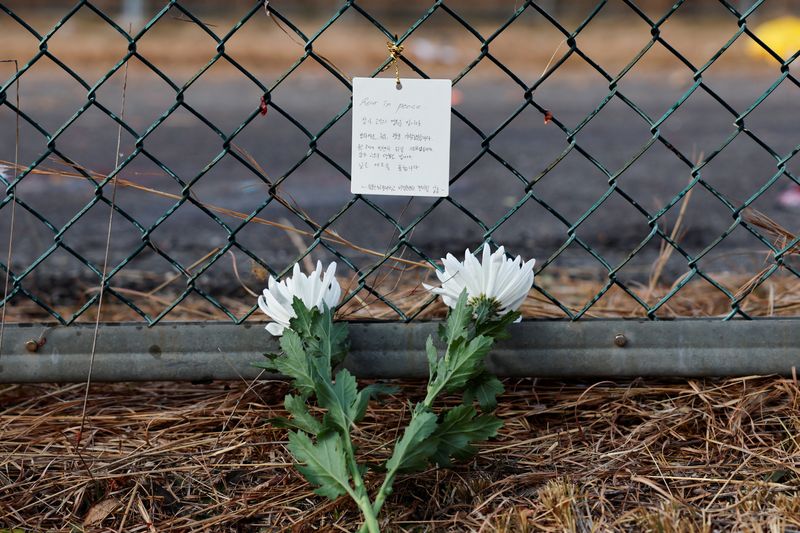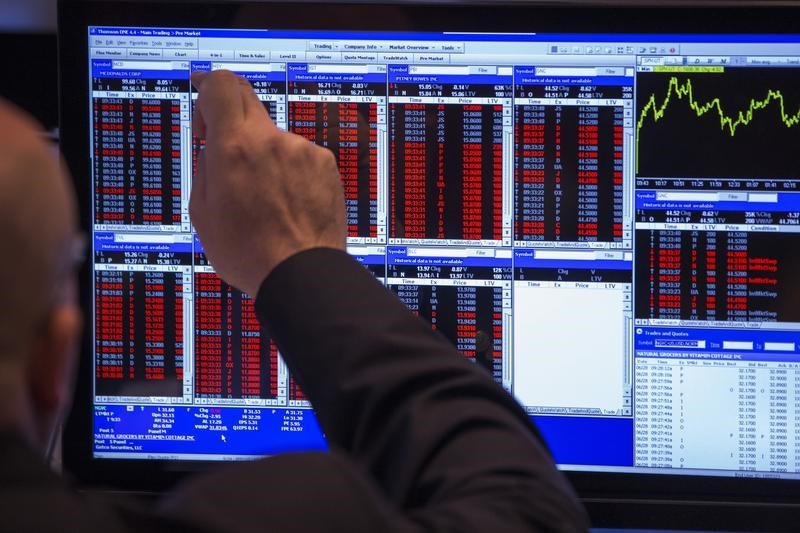By Ju-min Park and Hongji Kim
MUAN COUNTY, South Korea (Reuters) – South Korea’s acting President Choi Sang-mok ordered an emergency safety inspection of the country’s entire airline on Monday as investigators worked to identify victims and figure out what caused the deadliest air disaster on South Korean soil.
All 175 passengers and four of six crew members were killed when a Jeju Air Boeing (NYSE:) 737-800 belly-landed and skidded off the end of the runway at Muan International Airport, before erupting into a fireball as it struck crashed into a wall. Two crew members were pulled out alive.
The top priority for now is to identify the victims, support their families and treat the two survivors, Choi told a disaster management meeting in Seoul.
“Even before the final results are known, we ask that officials make the accident investigation process transparently public and immediately notify next of kin,” he said.
“Once the accident recovery is carried out, the Ministry of Transport is requested to conduct an emergency safety inspection of the entire aircraft flight control system to prevent the recurrence of aircraft accidents,” he said.
In a first step, the Ministry of Transport announced plans to conduct a special inspection of all 101 South Korean Boeing 737-800 aircraft starting Monday, focusing on the maintenance record of key components.
The 737-800 is one of the world’s most flown aircraft with an overall strong safety record. It was developed long before the MAX variant was involved in a recent safety crisis at Boeing.
Jeju Air flight 7C2216, arriving from the Thai capital Bangkok, attempted to land at the airport in the south of the country shortly after 9am (0000 GMT) on Sunday.
Investigators are looking into bird strikes, whether any of the plane’s control systems were disabled, and the pilots’ apparent haste to land shortly after a state of emergency was declared as possible factors in the crash, fire and transportation officials said.
Experts say many questions remain, including why the plane, powered by two CFM 56-7B26 engines, appeared to be traveling so fast and why its landing gear did not appear to be down as it moved from the runway to a concrete embankment slid.
“I can’t think of any reason to be forced to make a landing like this,” said aviation safety expert John Nance, a former military and commercial pilot who flew 737s for Alaska Airlines.
The plane landed at a high rate of speed and based on video, the pilots did not or could not take any steps to slow it down, Nance said.
CFM International is a joint venture between GE Aerospace and France Safran (EPA:).
On Monday, Department of Transportation officials said the pilots, as they made a planned approach, told air traffic control that the plane had suffered a bird strike, shortly after the control tower alerted them that birds had been spotted in the area.
The pilots then issued a Mayday warning, indicating their intention to abandon the landing and try again. Shortly afterwards, the aircraft belly landed on the runway, landed approximately 1,200 meters (1,310 yards) down the 2,800 meters (3,062 yards) runway and slid into the embankment at the end of the runway.
‘YOU HAVE NO WALL’
Officials are investigating what role the localizer antenna, which is located at the end of the runway to aid in landing, played in the crash, including the concrete embankment on which it sat, Department of Transportation officials told a news conference.
“Normally at an airport with a runway at the end you don’t have a wall,” says Christian Beckert, a flight safety expert and Lufthansa pilot based in Munich. “You might have another technical material retention system that allows the plane to sink into the ground a little bit and slow (it) down.”
The crash mainly killed locals returning from holidays in Thailand, while two Thai nationals were also killed.
“I can only accept it, make peace with it,” said Boonchuay Duangmanee, 77, the father of one of the Thai victims. “When I think about it, I remind myself that it was an accident. It’s something that could happen to anyone. So I’m at peace with it because no matter what I do, my daughter is not coming back.”
On Monday morning, investigators tried to identify some of the more than 20 remaining victims as anguished families waited in the Muan airport terminal.
Park Han-shin, who lost his brother in the crash, said authorities told him his brother had been identified but were unable to see his body.
Park called on victims’ families to unite in the response to the disaster, citing a 2014 ferry sinking that killed more than 300 people. Many relatives of the victims of the Sewol ferry disaster complained that it took too long for authorities to identify the deaths and the cause of that accident.
Transport ministry officials said the plane’s flight data recorder had been recovered, but it appeared to have suffered some external damage and it was not yet clear whether the data was sufficiently intact to be analyzed.
The recorder has been transported to Seoul and an analysis will begin when a team of officials from the U.S. National Transportation Safety Board and Boeing arrive in the country late Monday, the officials told reporters.
Muan International Airport remains closed through Wednesday, but the rest of South Korea’s international and regional airports, including Incheon’s main international airport, operated as planned.
Shares of Jeju Air hit all-time lows on Monday, trading as much as 15.7% lower. Shares of Boeing fell about 2%.
The craftsmanship and design of the 15-year-old plane are unlikely to play a role in the accident, but the crash underlines the “main risk” to aircraft makers’ stocks, Wolfe Research analyst Myles Walton wrote in a note.
Under global aviation rules, South Korea will lead a civil investigation into the crash and automatically involve the NTSB since the plane was designed and built in the United States.
A large memorial has been erected at a provincial gym about 9 km from the crash site, where people including acting President Choi came to pay their respects.

Choi, who is overseeing recovery efforts and investigations, became acting leader just three days ago after the country’s president and prime minister were ousted for imposing a short-lived martial law.
According to Marcos Alvarez, managing director of Global Insurance, the aviation insurance industry could face a claim of approximately $15 million to $20 million under the airline’s hull insurance, and total passenger liability claims of $120 million to $180 million as a result of the crash. ratings at Morningstar DBRS.


